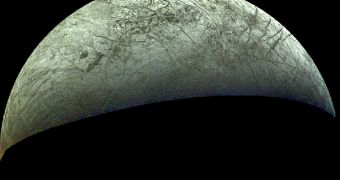A new NASA/ESA mission has been approved in order to investigate the Jupiterian moons of Europa and Ganymede, as well as low-scale analyses of other two moons of the giant planet, Io and Callisto. The mission, called the Europa-Jupiter System Mission (EJSM) will consist of two orbiters, one developed by NASA that will scour Europa's icy surface, while the other, devised by ESA, will perform scientific activities on Ganymede.
Our previous knowledge on Europa was provided by the Galileo spacecraft, which wondered around Jupiter's system between 1995 and 2003. It is known that a vast liquid ocean lies beneath an icy crust, and the new mission is focused on finding present or past signs of life, or at least check its habitability factor. Unfortunately, there's not much equipment that the modern technology allows to be sent so far in space, so landers or diving probes are out of the question for now.
According to Brad Dalton from NASA's Jet Propulsion Laboratory, one of the specialists involved in elaborating the paper for the proposal of the EJSM project, the instruments carried by the Europa orbiter will definitely include a camera, a spectrometer, as well as a powerful radar system that would allow seeing past the moon's icy crust and determining its thickness. "The Europa orbiter design is driven in part by the astrobiological significance of the Europa ocean, so it will be focused more on direct evidence for the ocean and the tidal flexing that keeps it liquid," explains Dalton, quoted by Space.
"We tried very hard, within our cost and mass constraints, to come up with a realistic lander concept," shares the scientist. "The truth is, for the amount of mass and cost it adds, it's very difficult to include sufficient scientific capability to make it worthwhile. Part of the problem is in understanding the surface well enough to constrain the design. Once you get there, of course you are going to want to dig - and that is just outside of the current fiscal reality." Among the tiny devices that could be carried, though, are a seismometer, measuring the amount and frequency of Europa's ice crust shifts, and a mass spectrometer analyzing the chemistry within it.

 14 DAY TRIAL //
14 DAY TRIAL //